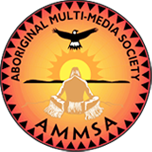Article Origin
Volume
Issue
Year
Page 14
Have you ever seen healthy, smiling faces of Native couples in love, Native couples so completely immersed in each other's love? Have you ever seen brown skin loving brown skin, Native lips kissing other Native lips in television, film, video, or the many different forms of print?
It's pretty safe to say that most people have not. I know I have never seen
images of myself - as a Native woman - represented in any medium as a happy, healthy, sensual/sexual being capable to love and being loved by a man from my own culture.
What does the absence of loving/sexual Native images communicate to ourselves, our children, to others outside our cultures? If we cannot see representations of ourselves as loving, healthy, happy, sensual/sexual Native peoples in books, magazines, films, videos, and television are we saying to non-Native people that we are not loving, happy, sexual beings?
A short time ago I happened to look upon my son and his non-Native girlfriend as they shared a very intimate moment. I watched as he very lovingly kissed her and held her close. I was so moved by the depth of his feelings for her.
Sometimes later I asked him: "Why don't you ever date Native girls?" Even before the last words came out of my mouth I knew. I suddenly thought of all those Cindy Crawford, Claudia Schiffer, Madonna-type pin-up posters that both my sons have adorning their walls and that Native girls/women don't fit the ideal beauty myth.
Perhaps the same might be said for young Native men. Certainly, Native girls active in the social scene are susceptible to the same kinds of pressures - they want to
be loved and to love a young man who also fits the ideal male myth. And, do Native men fit the ideal male myth? I think not.
The lack of images of ourselves as attractive, happy, healthy, sensual/sexual beings tells me that we are not worth loving. That we are incapable of loving each other! It also tells me that we cannot be romantic or sexual with each other, that's there's something wrong or even perverse in desiring each other's bodies.
We've certainly seen enough images of ourselves as unhealthy, unhappy, un-whole and dysfunctional peoples. Oh, and yes, we've seen images of the white woman/Native man or Native woman/white man romantic combination, which usually ends in disaster and, more often than not, as a result of the Native's persons's seemingly inherent character flaw.
As Native peoples, we talk so much about restoring ourselves to balanced, respectful beings. We call upon that oh-so-tiresome word "heal" to remind us of our pain and misery.
We need to remember that we have happiness, beauty, strength, power, sensuality, and sexuality in our cultures, too. We need to represent those kinds of images through our art, music, and other kinds of cultural reminders of ourselves.
I know that some Native people are struggling to represent those aspects of our cultures through their work. Unfortunately, I'm too often reminded that publishers, filmmakers and producers are just not interested in love stories about healthy, happy, Native peoples.
I've surmised that white audiences therefore are only interested in us when we're hurting each other, killing one another off, or suffering from alcoholism or drug addiction. Isn't that the most powerful propaganda that keeps us disempowered?
- 718 views
